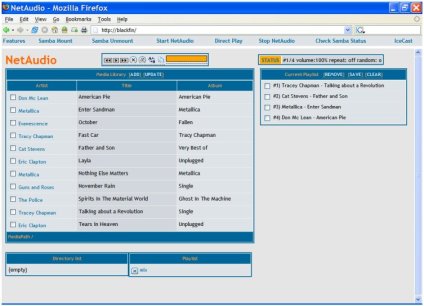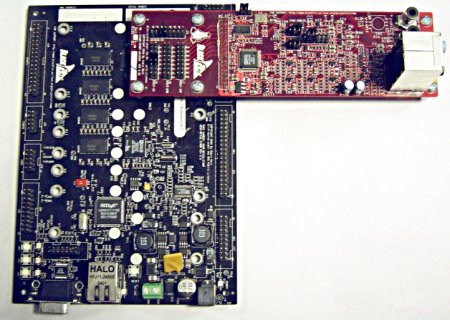Blackfin uClinux platform runs networked audio player
Mar 29, 2005 — by LinuxDevices Staff — from the LinuxDevices Archive — 20 viewsForeword — This article discusses the first Linux audio application to run on the Analog Devices Blackfin, which was one of the first DSPs to run Linux. The application is a network music player demonstrated by ADI recently at ESC (Embedded Systems Conference). Enjoy . . . !
by Maggie Nakhla
Analog Devices Inc. (ADI) demonstrated a networked audio player, running uClinux on the Blackfin STAMP Board at the Embedded Systems Conference in San Francisco. The demonstration consisted of an audio player that played audio files (Ogg Vorbis, WAV, MP3, FLAC and AAC) stored in a network directory in a remote PC. These audio files were mounted using SAMBA file sharing and controlled through an http interface.
Integrated SoftTech Solution Pvt Ltd., (iSoftTech) ported / cross-compiled the Music Player Daemon (MPD) to uClinux for the ADSP-BF533 Blackfin Processor. MPD is an open source server application that allows remote access for playing music (MP3, Ogg Vorbis, FLAC, AAC, Mod, and wave), and managing playlists. The networked audio application also features SAMBA support, which allows for mounting files from a remote Linux or Windows machine. In addition, the latest BOA web server has been ported to the ADSP-BF533.
This application is the first audio application that is running the Blackfin STAMP Board. The STAMP board was designed specifically for developing and building Linux based embedded systems, and includes the full compliment of memory along with serial and networking interfaces. The kernel was automatically loaded via Ethernet to the board upon reset (Das U-boot was used as the networked boot loader).
Running the whole Application on Blackfin caused just a single digit percentage system load.
A screenshot of the networked audio web interface is shown below. The audio files that have been mounted are listed in the Media Library. Through this web interface, multiple playlists can be created and managed, and the status of the audio file that is playing can be viewed. This page also has links to view the status of the Samba Mount.

The interface
(Click to enlarge)
The application runs on a BF533 STAMP board with a daughter card featuring the AD1836A high-performance, single-chip audio codec (supports 24 Bits and 48 kHz Sample Rate, providing three stereo DACs and two stereo ADCs). The code and schematics for this project will be available at online in the next few months.

ADI's STAMP board, with audio daughtercard
(Click to enlarge)
Now that a working boot loader, uClinux kernel, audio driver, and network driver have been shown on the Blackfin based STAMP board, these hardware/software components could be reconfigured to demonstrate such applications as TCP/IP-based speakers, voice over IP communications, networked based voice mail, or others.
In addition to a Blackfin Processor and supporting circuitry, the Blackfin STAMP Board also provides 4 MB of flash memory and 128 MB of SRAM, plus a 10/100 Ethernet controller, serial and parallel ports, a standard JTAG interface, timers, power supply, and a set of I/O headers suitable for off-board cable expansion, or expansion via a local daughterboard. The BSP also includes a GNU toolchain, Das U-boot boot loader, JTAG tools, the CYGWIN (Linux on Windows) tool, documentation, and board schematics.
STAMP boards are available today. The part number is ADDS-BF533-STAMP. You can find a list of local distributors here. Audio cards will be available later this summer.
About the author — Maggie Nakhla is program manager of ADI's Platform Tools Group.
This article was originally published on LinuxDevices.com and has been donated to the open source community by QuinStreet Inc. Please visit LinuxToday.com for up-to-date news and articles about Linux and open source.